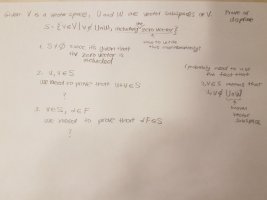Prove or disprove the following claim:
V is a vector space; U and W are vector subspaces of V. Let S be the group of all vectors is V which do not exist in the intersection of U and W, in addition to the zero vector. S is a vector space (over the same field, and with the same operations as in V).
I am going to assume that V is a finite dimensional vector space over a field k.
Express V as the span of a basis. Then [imath]V = span \{ e, ~ v_1, ~ v_2, \text{ ...} \}[/imath].
Then let U and W be expressed in terms of basis vectors [imath]U = span \{e, ~ v_{i_1}, ~ v_{i_2}, \text{ ...} \}[/imath] and [imath]W = span \{e, ~ v_{j_1}, ~ v_{j_2}, \text{ ...} \}[/imath].
Now for these basis vectors we need:
For V: [imath]a e + b v_1 + c v_2 + \text{ ...} = 0 \implies a = b = c = ... = 0[/imath]
For U: [imath]d e + f v_{i_1} + g v_{i_2} + \text{ ...} = 0 \implies d = f = g = ... = 0.[/imath]
For W: [imath]h e + m v_{j_1} + n v_{j_2} + \text{ ...} = 0 \implies h = m = n = ... = 0.[/imath]
Construct S in terms of the basis vectors of V, [imath]S = span \{e, ~ v_{p_1}, ~ v_{p_2}, \text{ ...} \}[/imath]. So you need to prove that there exist q, r, s... in k such that
[imath]q e + r v_{p_1} + s v_{p_2} + \text{ ...} = 0 \implies q = r = s = ... = 0.[/imath]
-Dan
Addendum: As Zermelo says, try this with a few (low dimensional) examples. The pattern should be clear.

